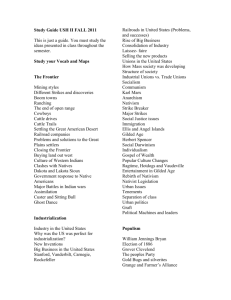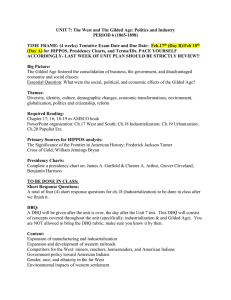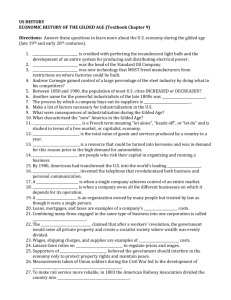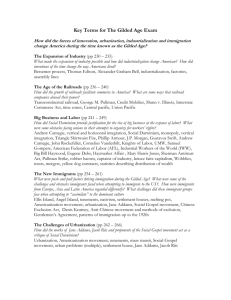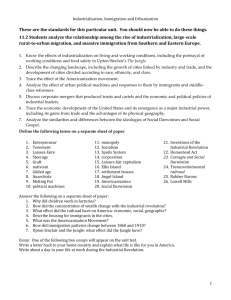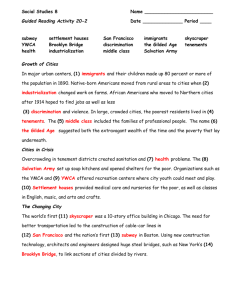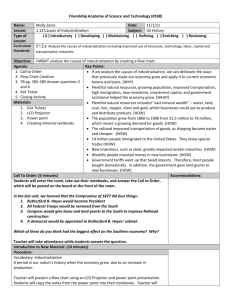The Industrial Revolution
advertisement
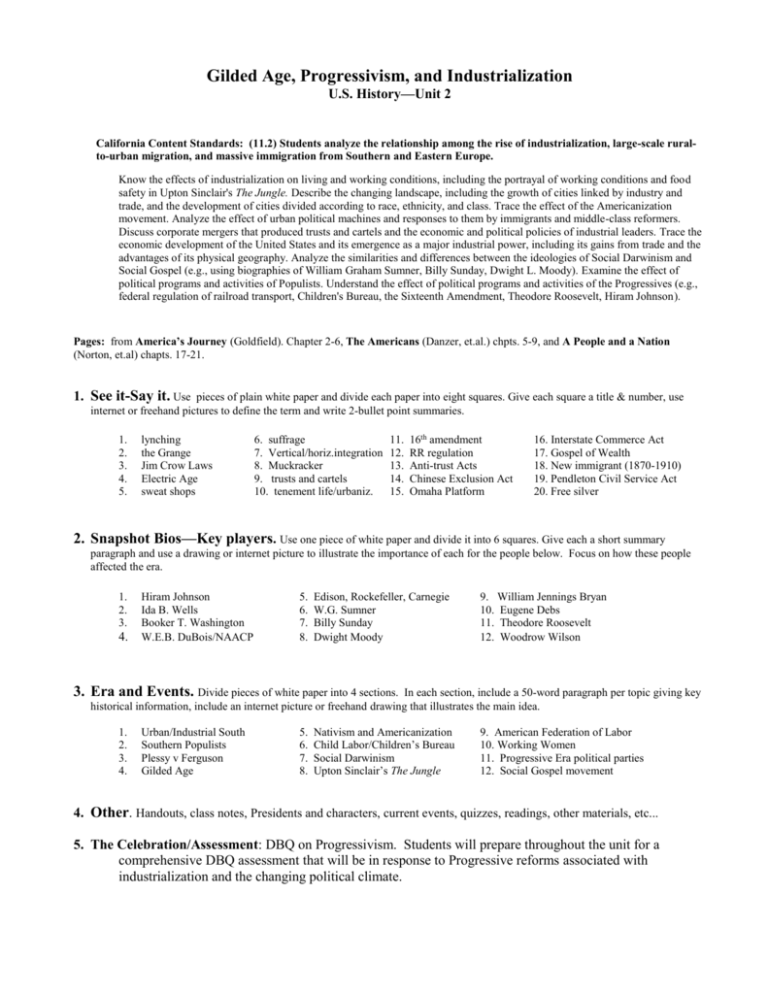
Gilded Age, Progressivism, and Industrialization U.S. History—Unit 2 California Content Standards: (11.2) Students analyze the relationship among the rise of industrialization, large-scale ruralto-urban migration, and massive immigration from Southern and Eastern Europe. Know the effects of industrialization on living and working conditions, including the portrayal of working conditions and food safety in Upton Sinclair's The Jungle. Describe the changing landscape, including the growth of cities linked by industry and trade, and the development of cities divided according to race, ethnicity, and class. Trace the effect of the Americanization movement. Analyze the effect of urban political machines and responses to them by immigrants and middle-class reformers. Discuss corporate mergers that produced trusts and cartels and the economic and political policies of industrial leaders. Trace the economic development of the United States and its emergence as a major industrial power, including its gains from trade and the advantages of its physical geography. Analyze the similarities and differences between the ideologies of Social Darwinism and Social Gospel (e.g., using biographies of William Graham Sumner, Billy Sunday, Dwight L. Moody). Examine the effect of political programs and activities of Populists. Understand the effect of political programs and activities of the Progressives (e.g., federal regulation of railroad transport, Children's Bureau, the Sixteenth Amendment, Theodore Roosevelt, Hiram Johnson). Pages: from America’s Journey (Goldfield). Chapter 2-6, The Americans (Danzer, et.al.) chpts. 5-9, and A People and a Nation (Norton, et.al) chapts. 17-21. 1. See it-Say it. Use pieces of plain white paper and divide each paper into eight squares. Give each square a title & number, use internet or freehand pictures to define the term and write 2-bullet point summaries. 1. 2. 3. 4. 5. lynching the Grange Jim Crow Laws Electric Age sweat shops 6. suffrage 7. Vertical/horiz.integration 8. Muckracker 9. trusts and cartels 10. tenement life/urbaniz. 11. 12. 13. 14. 15. 16th amendment RR regulation Anti-trust Acts Chinese Exclusion Act Omaha Platform 16. Interstate Commerce Act 17. Gospel of Wealth 18. New immigrant (1870-1910) 19. Pendleton Civil Service Act 20. Free silver 2. Snapshot Bios—Key players. Use one piece of white paper and divide it into 6 squares. Give each a short summary paragraph and use a drawing or internet picture to illustrate the importance of each for the people below. Focus on how these people affected the era. 1. 2. 3. 4. Hiram Johnson Ida B. Wells Booker T. Washington W.E.B. DuBois/NAACP 5. 6. 7. 8. Edison, Rockefeller, Carnegie W.G. Sumner Billy Sunday Dwight Moody 9. William Jennings Bryan 10. Eugene Debs 11. Theodore Roosevelt 12. Woodrow Wilson 3. Era and Events. Divide pieces of white paper into 4 sections. In each section, include a 50-word paragraph per topic giving key historical information, include an internet picture or freehand drawing that illustrates the main idea. 1. 2. 3. 4. Urban/Industrial South Southern Populists Plessy v Ferguson Gilded Age 5. 6. 7. 8. Nativism and Americanization Child Labor/Children’s Bureau Social Darwinism Upton Sinclair’s The Jungle 9. American Federation of Labor 10. Working Women 11. Progressive Era political parties 12. Social Gospel movement 4. Other. Handouts, class notes, Presidents and characters, current events, quizzes, readings, other materials, etc... 5. The Celebration/Assessment: DBQ on Progressivism. Students will prepare throughout the unit for a comprehensive DBQ assessment that will be in response to Progressive reforms associated with industrialization and the changing political climate.
